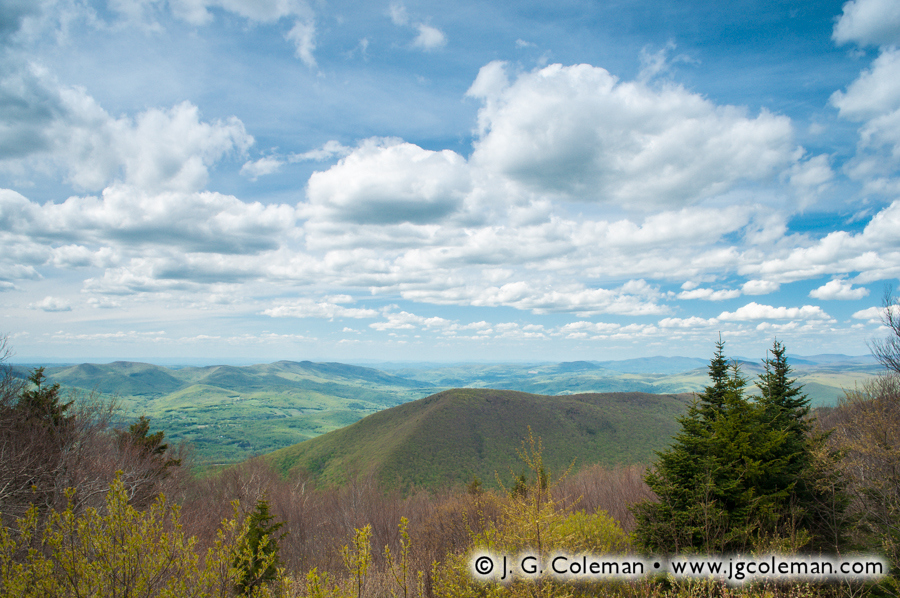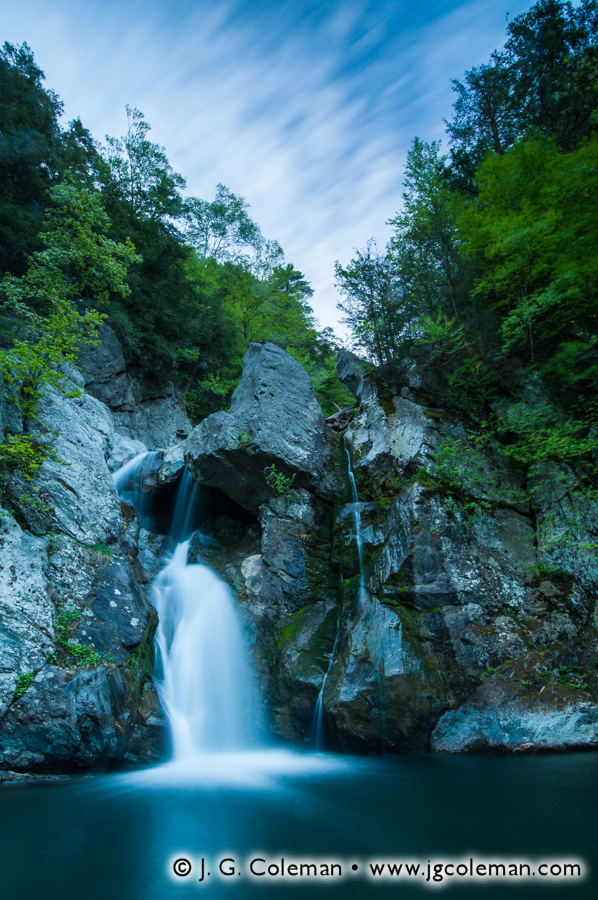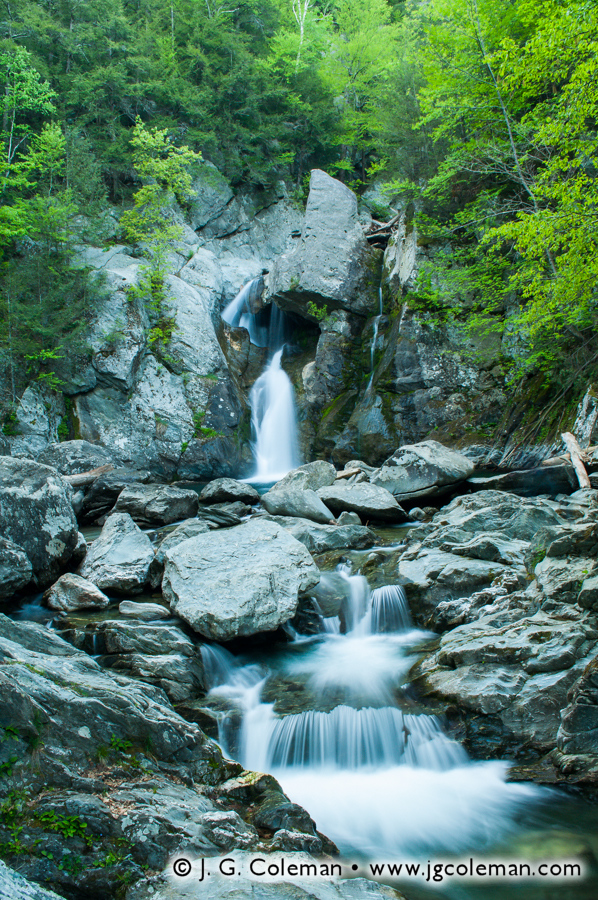
Mount Greylock State Reservation, Adams, Massachusetts
© 2013 J. G. Coleman
Over the next few weeks, I’ll be taking you along on an odyssey through the Berkshire landscapes as I release several new fine art prints in a three-part series I’ve titled Journey Into the Berkshires. We’ll experience some of the region’s most exquisite and awe-inspiring scenery and delve into the fascinating lore that underlies this rural back-country in western Massachusetts. For the first installment of the series, I’ve decided to introduce you to two of the Berkshires most famous natural places; beacons of wild beauty that have inspired travelers and artists for generations.
Mount Greylock
Adams, Massachusetts
When C. W. Bryan sat down in the 1880s to write about the panoramic views from the summit of Mount Greylock, he began by conceding that “the pen cannot describe the scene”. The perspective from this massive mountain, which climbs more than 2,000 feet over the surrounding valleys and affords 100-mile views into neighboring states, is one of the most impressive in all of Southern New England.
In my new piece, Greylock Vista (above), we are whisked to the upper slopes of Mount Greylock where a grand panorama unfolds before our eyes. The deeply-furrowed expanses of the Berkshires reveal themselves as a majestic procession of broad, forest-laden slopes and rural valleys that stretch to a distant horizon beneath a hazy blue sky ripe with gentle clouds.
Spanning several towns in the far northwest corner of Massachusetts, Mount Greylock reaches a height of just under 3,500 feet above sea level, making it the highest summit in Berkshire County. Indeed, taking in the view from this towering peak has long been considered one of the quintessential aesthetic experiences of the Berkshires. It is no surprise, then, that Mount Greylock was the first swath of territory set aside by the State of Massachusetts in an effort to protect forestland and preserve natural heritage. Created in 1898, Mount Greylock State Reservation has steadily grown since its it inception, now encompassing more than 12,000 acres of rugged land radiating from the summit.
The name, “Mount Greylock”, first appeared in writing in the early 1800s and had become widely-used only a few decades later, but there’s still some measure of mystery as to its origin. Some attribute the name to the gray clouds that occasionally cling to the mountain’s summit, said to resemble locks of gray hair. Other sources claim that the mountain was named in honor of Chief Grey Lock, a Western Abenaki warrior that led several bloody campaigns against the English in Massachusetts during the 1720s. Grey Lock was one of New England’s “most wanted” for a number of years and the colonists made several efforts to hunt him down. The cunning warrior thwarted every attempt, eventually retiring from active warfare and, by all accounts, living to a ripe old age.
Chief Grey Lock spent many of his years on the move between Massachusetts and Vermont, though there doesn’t seem to be any credible story that directly associates him with Mount Greylock. Perhaps it simply seemed fitting to name such an imposing mountain after such an infamous, larger-than-life warrior.

Bash Bish Falls State Park,
Mt. Washington, MA
© 2013 J. G. Coleman
Bash Bish Falls
Mt. Washington, Massachusetts
Departing the slopes of Mount Greylock and heading some 40 miles south to the town of Mount Washington, we arrive at the equally-famous and much celebrated Bash Bish Falls. “It is not without a silencing thrill of delight that the cataract of Bashbish greets the vision,” wrote one 19th-century visitor. Another writer dubbed them “the anthem of Nature’s hymn in New England.” Indeed, Bash Bish Falls is the scenic epicenter of the southern Berkshires and the subject of more than a century-and-a-half of paintings, poems and photographs.
But despite the abundance of works inspired by this natural landmark, my piece Bash Bish Twilight nonetheless offers a vista of the falls in an uncommon light: the early hours of morning, before the sun has risen. Illuminated only by soft, reflected light from the sky above, the weathered rock faces of the gorge take on a palette of cool color tones as Bash Bish Brook spills from the uppermost ledges, sending a plume of water careening into the pool below. Above the shadowy forest on the gorge rim, the clouds have been transformed into dreamy wisps with the help of a long shutter speed.
Just as with Mount Greylock, there is a certain degree of mystery regarding how Bash Bish Falls came to be named. Perhaps the simplest explanation is that the name is onomatopoeic: the plunging water is said create a gurgle that vaguely sounds like “bash bish”. However, there is an alternate legend that accounts for the name with a much more intriguing story.
The account tells of a beautiful Native American woman named Bash Bish, who was falsely accused of adultery by an envious member of her tribe. For unknown reasons, the tribe determined that she was guilty and ought to be punished by death. In a gruesome spectacle, she was strapped to a canoe and set adrift down the brook, eventually careening over the waterfall. When the tribe attempted to find Bash Bish’s body, though, they could recover only broken fragments of the canoe. The mysterious lack of a body spooked the tribe, who concluded that she must have been a witch.

Bash Bish Falls State Park,
Mt. Washington, MA
© 2013 J. G. Coleman
Bash Bish was gone, but she had left behind a daughter by the name of White Swan. Over the years following her mother’s death, White Swan had grown to be quite beautiful herself, eventually marrying Whirling Wind, the son of a prestigious chief. The two were deeply in love and all was well for the couple, except for glaring fact that they seemed unable to conceive a child. White Swan, having been eager to bear a child for her husband, was crushed at the realization that it was proving impossible. Fraught with misery, she climbed to the precipice above Bash Bish Falls and jumped, meeting her fate on the same waters that claimed her mother years earlier. What she didn’t realize is that Whirling Wind had secretly followed her; perhaps he thought she had simply gone to the falls to think, and he was hoping to comfort her. He instead arrived just in time to see her jump. Grief-stricken, he too cast himself into rocky waters below. In the aftermath of the tragedy, the tribe pulled the battered body of Whirling Wind from the waters; White Swan was never found. Fleeting images of Bash Bish and White Swan are said to be momentarily visible in the cascading waters of Bash Bish Falls to this day.
But whereas Chief Greylock was undoubtedly a real Abenaki warrior of the 18th-century, there doesn’t seem to be any mention of Bash Bish and White Swan in old records. The legend seems to have emerged out of nowhere in a few obscure sources in the 1950s, always being billed as lore passed down from local tribes. Yet it’s curious that this legend was apparently not prominent enough to make it into Clark Bryan’s Book of Berkshire, published some 70 years earlier in 1880s. Perhaps it’s simply a fantastic story that was dreamed up at some point during the early 20th-century in order to put a mysterious spin on the peculiarly-named landmark. Or maybe… just maybe… there is a vein of truth to this story of love, loss and untimely death in an era before Europeans.
After all, Bash Bish Falls is apparently just as perilous as it is scenic; “the most deadly waterfall in the United States” according to some sources. Whether or not that superlative rings true is probably tough to pin down, but when you consider that over two-dozen people have perished at Bash Bish Falls in recorded history, the facts alone are shocking enough.
On to the Next Journey…
There’s little doubt that the Berkshires are a place of inspiring beauty, and we’ll continue to explore the natural treasures of these mountains through the fine art prints featured in my next installment of Journey Into the Berkshires. But as we’ve already discovered with the tales of Chief Greylock, Bash Bish and White Swan, there’s an ancient and storied history that dwells in these wild expanses of Western Massachusetts. The legends that have grown out of the Berkshires are a captivating and haunting blend of fact and fiction, of the real and the surreal. With my photographic depictions of this rugged territory, I seek not only to capture the enchanting beauty of the landscape, but also to instill within my works a subtle bridge into the past… into the primeval contours of the land… into the enigmatic generations of souls that have loved, lost, lived and died in these mountains for untold centuries.
Want to See More?
- To buy a fine art print of any of the pieces seen above, visit my gallery pages for “Greylock Vista”, “Bash Bish Twilight” and “Falls of Bash Bish Creek”.
- To see more of my work from Bash Bish Falls, visit my online galleries and check out the Bash Bish Falls State Park collection.
- Read the second installment of Journey Into the Berkshires.

